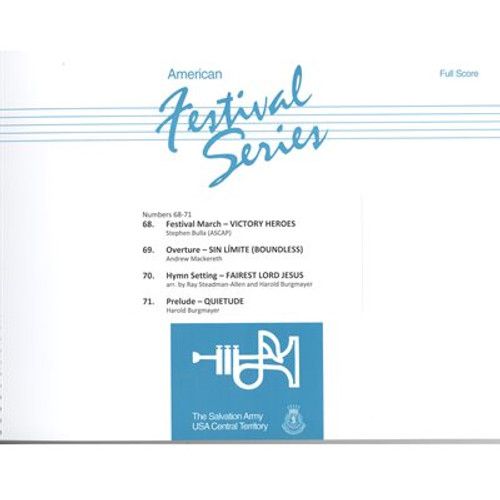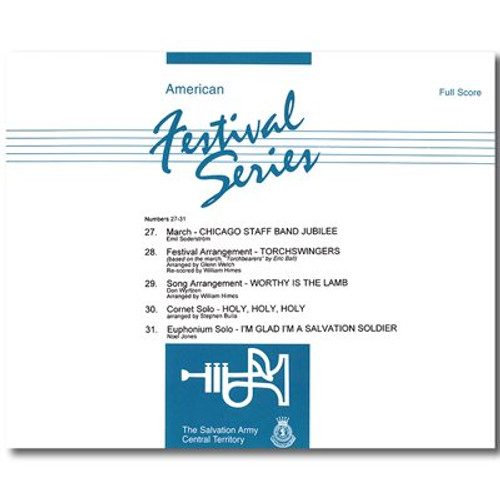Product Description
December 2010 Nos. 44-46
Brian Bowen, Editor
Comments by
Staff Bandmaster William HimesMusic & Gospel Arts Secretary, USA Central Territory
Preface
This issue has everything to do with anniversaries as we have included two works written for the centenary of the Chicago Staff Band (1907-2007) by James Curnow and Kenneth Downie and a pastoral commemorating the eightieth birthday of my father, William Himes, Sr.
Pondering this happy coincidence caused me to realize afresh music's power to mark time and help us remember. Romantics will remember the song that was playing on their first date - especially with the one who became their spouse. Families will wistfully recall songs that were near and dear to their parents. And many of us will remember the song that touched our heart the day we became a follower of Christ.
As with all Salvation Army music, may these pieces, written to celebrate God's faithfulness and blessing, continue to be a means of drawing listeners and musicians closer to Him.
| 44. | Festival Prelude - Hallelujah! | James Cornow | Notes |
| 45. | Selection - Festival of Thanksgiving | Kenneth Downie | Notes |
| 46. | Pastorale - Previous Fountain | William Himes | Notes |
Produced by The Salvation Army - Central Territory
44. Festival Prelude - Hallelujah!
Program Note:
This festive opener, written for the Chicago Staff Band's 100th anniversary (1907-2007), is an aggressive call to action inspired by James Montgomery's hymn, "Stand up and bless the Lord" and includes the chorus, "Praise ye the Lord, hallelujah!"
This festive opener, written for the Chicago Staff Band's 100th anniversary (1907-2007), is an aggressive call to action inspired by James Montgomery's hymn, "Stand up and bless the Lord" and includes the chorus, "Praise ye the Lord, hallelujah!"
Note to the Conductor:
While this festival prelude abounds in energy and color, it is the composer's intent to portray a mood that is noble and heroic.Therefore the overall style should be spirited yet sustained unless otherwise indicated by accents.
The introduction hints at a heroic motif which comes to full fruition at bar 51 (flugel, horns). All of this prepares the theme of praise with the trombone section's presentation of the hymn tune, "Falcon Street" at bar 63. This is interrupted with festive references to the opening motif until the chorus appears at bar 113 as it is tossed from horns to cornets, concluding with a dazzling flourish.
Strive for a steady tempo that adheres to the 112-116 metronome marking while proportioning dynamics, taking particular care to distinguish between f and ff.
45. Selection - Festival of Thanksgiving
Program Note:
Written to commemorate the Chicago Staff Band's 100th anniversary (1907-2007), this vibrant work utilizes several themes of praise from universal and personal perspectives to express our thanksgiving to God. Traditional melodies include "Let us with a gladsome mind," "To God be the glory," "Thank you, Lord, for saving my soul" and "Now thank we all our God."
Written to commemorate the Chicago Staff Band's 100th anniversary (1907-2007), this vibrant work utilizes several themes of praise from universal and personal perspectives to express our thanksgiving to God. Traditional melodies include "Let us with a gladsome mind," "To God be the glory," "Thank you, Lord, for saving my soul" and "Now thank we all our God."
Note to the Conductor:
As one would expect of the music of Kenneth Downie, this work abounds with color and energy as well as some technical challenges. Nevertheless, bands will find that thorough rehearsal will be well worth the effort as this praise setting comes to life.
Introduction: Opening with a transparent rendering of the hymn tune, "Monkland," give careful attention to the tuning of flugel and solo horn at bar 3, with its intentional dissonance and resolution.
Bars 12-19: The second rendering of the tune is full and sonorous, yet slightly quicker. The little fanfare at bar 14 (1st baritone, 1st and 2nd trombones) must be clear, precise and measured.
Bars 20-81: This bright allegro section will require lots of attention to the sudden dynamic sweeps (i.e., bars 32-33) and technical demands that are tossed to virtually every section, but from bar 39 keep the tune, "To God be the glory" to the fore.
Bars 82-98: This section transitions to the tranquil, reflective scene to come with a large-scale rallentando from bar 85 to 98. The composer has provided helpful "mile markers" along the way to give a clear sense of proportion as the pace slows. Be alert to the references to "Praise, my soul, the King of Heaven" sprinkled throughout. Note the first reference at bars 81-82 where it appears in solo cornet and Bb bass - four octaves apart!
Bars 99-114: The well known chorus, "Thank you, Lord, for saving my soul," is presented in here with tenderness and simplicity. Let the flugel solo establish the mp dynamic level with the accompaniment movement and sonority in hushed support.
Bars 115-121: This section serves to bring the mood to a quiet conclusion with a relatively quick transition to the allegro vivo which follows. The first hint of something to come is provided by the soft but accented articulation in 1st and 2nd horns (with bells) at bar 120. Then it is up to the euphonium to quickly accelerate in just one bar to the next section.
Bars 122-151: The energy of this section can tempt players to play louder than the music asks. While there are some important dynamic sweeps - especially in the trombone section - give care to restrain the excitement so that the declarative presentation of "Now thank we all our God" at bar 130 is no more than forte. This leaves some room for the sudden fortissimo at bars 135-140 with the percussion leading the charge.
Just as suddenly, the music drops to mp at bar 141, but with no loss of tempo. Meter changes in bars 142-151 will need to be carefully worked out, keeping the eighth-note (quaver) speed constant.
Bars 152-166: This section features sonorities that are at once huge and balanced, along with a gradual slowing and softening of sound and mood. Another accelerando follows, but this time arriving at a noble pace for the final statement of the hymn. Again, observe the composer's helpful tempo indications.
Bars 167-end: "Now thank we all our God" returns with quiet solemnity. Observe and carefully pace the indicated dynamics, saving the ultimate fff for the final bar.
46. Pastoral - Previous Fountain
Program Note:
A reflective setting of the classic gospel song, "Jesus, keep me near the cross" by Fanny Crosby (1820-1915) to the German tune, "Healing Stream." The composer wrote this as a gift for his father's 80th birthday. This song has special significance in that it was often sung during family devotional times and around the dinner table.
A reflective setting of the classic gospel song, "Jesus, keep me near the cross" by Fanny Crosby (1820-1915) to the German tune, "Healing Stream." The composer wrote this as a gift for his father's 80th birthday. This song has special significance in that it was often sung during family devotional times and around the dinner table.
Note to the Conductor:
As the program note implies, this is music that is warm and emotional, drawing on happy memories of a young (and large) family growing up together in the Lord.
There are few if any technical challenges, with lots of opportunity for lyrical, expressive playing. As cliche as it may sound, connecting the words with the music will greatly enhance the interpretation of this four-verse setting.







